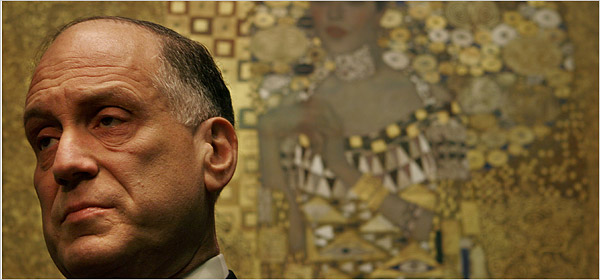The New York Times reports: As he stood in the opulent marble foyer of a Fifth Avenue mansion late last month, greeting the coterie of prominent guests arriving at his private art gallery, Ronald S. Lauder was doing more than just being a gracious host.
To celebrate the 10th anniversary of the Neue Galerie, Mr. Lauder’s museum of Austrian and German art, he exhibited many of the treasures of a personal collection valued at more than $1 billion, including works by Van Gogh, Cézanne and Matisse, and a Klimt portrait he bought five years ago for $135 million.
Yet for Mr. Lauder, an heir to the Estée Lauder fortune whose net worth is estimated at more than $3.1 billion, the evening went beyond social and cultural significance. As is often the case with his activities, just beneath the surface was a shrewd use of the United States tax code. By donating his art to his private foundation, Mr. Lauder has qualified for deductions worth tens of millions of dollars in federal income taxes over the years, savings that help defray the hundreds of millions he has spent creating one of New York City’s cultural gems.
The charitable deductions generated by Mr. Lauder — whose donations have aided causes as varied as hospitals and efforts to rebuild Jewish identity in Eastern Europe — are just one facet of a sophisticated tax strategy used to preserve a fortune that Forbes magazine says makes him the world’s 362nd wealthiest person. From offshore havens to a tax-sheltering stock deal so audacious that Congress later enacted a law forbidding the tactic, Mr. Lauder has for decades aggressively taken advantage of tax breaks that are useful only for the most affluent.
The debate over whether to reduce tax shelters and preferences for the rich is one of the most volatile in Washington and will move to the presidential campaign, now that repeated attempts in Congress to strike a grand bargain over spending cuts and an overhaul of the tax code have failed.
There’s an interesting backstory to this article. Charles Finch notes that since the Lauder group of companies are among the most lucrative of the New York Times‘ advertisers, “endangering this cosmetic revenue stream seems suicidal at best.” But Finch goes on to note the fiercely competitive relationship between the Lauder brothers, Ronald and Leonard (both collectors of Klimt), and writes:
[T]o ascertain, perhaps, what is really going on, one must go back to the book of Genesis, specifically to the tale of Cain and Abel. There has always been a presumptive sense of art-collecting museo-competition between the czar of MoMA, Ron, and the head of the inferior Whitney Museum, Leonard. Ron has always won this battle convincingly, in spite of the fact that he has been (as copiously detailed in the Times article) a dilettante, while older brother Leonard has run the family business.
Additionally, Leonard’s deceased bride Evelyn was a major hands-on executive and new product innovator in the Lauder cream stream. So let’s look deeper into the Times‘ expose. First, Ron’s position as CEO of Clinique is characterized as a sinecure and his business skills, relative to the company, as nonexistent.
Elements of Ron’s checkered career, especially his short and troubled stint as Ronald Reagan’s Ambassador to Vienna and his multimillion-dollar run for NYC mayor, are elucidated. And who do you think the Lauder relatives were who lent all their company stock to Ronald for tax avoidance purposes? The Leonard Lauder family.
To conclude, dear readers, who would be the only source kosher enough to green light the Times expose of Ronald Lauder’s tax strategies, while keeping the paper’s relationship with Estée Lauder safe and enjoying a little fraternal revenge under a cloud of personal grief? Leonard Lauder, of course!



I love the file name for that photo of Ronald Lauder: “lauder-without-makeup”! He certainly does not look like a very pleasant fellow.
Sometimes my jokes are so covert I expect I’m the only one who will get to giggle — glad you caught this one Dickerson!
I can’t help wondering how a New York Times photographer sets up a photo like this:
“OK. Move a bit to your right Mr Lauder — I want to get a good chunk of the Klimt in the background. Now, chin up and give me your ugliest face.”
Snap.
“Perfect. No wonder everyone hates the 1%”